Last week me and Huck (my 6-month-old) started a new family tradition.
The Tradition: Driving to Home Depot, him screaming at the top of his lungs, us buying a Christmas tree and letting the tree nearly fly off of the top of the car on the way home.
Incredible tradition. You should try it. 🙂
Growing up my dad always got a kick out of hiding and disguising our Christmas presents. One year me and my brother woke up, rushed into the living room and found two gigantic boxes beside the tree. I’m talking BIG boxes. Refrigerator-sized boxes.
See, in prior years we had developed a bad habit of shaking our presents to figure out what was inside them. My dad wasn’t a big fan of this. So that year he wrapped all of our gifts up like normal but then stuffed them inside gigantic boxes. Then he wrapped the gigantic boxes up.
There was exactly a 0% chance of us shaking the gigantic refrigerator box.
= Mission Accomplished.
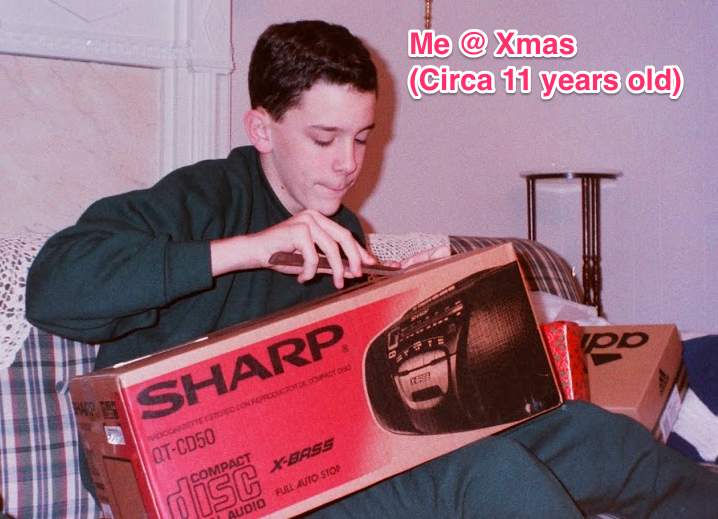
Other years produced many other crazy harebrained ideas from my dad.
It was fun though. It was a cool tradition.
I like traditions.
Last year I inadvertently started a new tradition on this blog. I wrote this recap article of the first major product launch I ever did. And then a few months later I followed it up with a recap of the first 10ksubs product launch.
Looking back on those articles, they were two of the most fulfilling (and best) articles I ever wrote. You guys commented, emailed and told me in person how much they’ve helped you and how much you enjoyed them.
So, going forward we’re going to keep that tradition alive!

At the end of every product launch we do, I’ll do a detailed analysis of what went right, what went wrong, a revenue breakdown and other fun stuff we discovered along the way.
That’s exactly what this article is.
2 weeks ago we wrapped up the Fall 2015 enrollment into our primary product, Get 10,000 Subscribers. This article will deconstruct that product launch so you can learn from our mistakes and occasional genius decisions.
So I have no plans to stop sharing launch revenue but I don’t want that to be the emphasis.
I don’t want these articles to read like “Oh hey! Look at all this money we made! Ain’t that cool!” Those types of articles suck. They make it sound too “Get rich quick” for my taste. They can be misleading.
Instead, the emphasis of these launch recap posts will be on what we did, what we screwed up on and how you can learn from that.
Table of Contents
To make things a smidge easier to navigate, I’ve put this fancy little table of contents at the top.
Part 1: The results of the launch (revenue, new students…all dem fun numbers)
Part 2: The sequence of events (everything we did and the order we did it in)
Part 3: Our paid advertising strategy that worked (sorta)
Part 4: How we used upsells to generate over $30,000 in additional revenue
Part 5: Random stuff (Q&A, lessons learned, ideas for next time)
Onward!
Part 1: The results of the launch (and one big lesson)
Alright, before we get into all the details of what we did and how we did it, let’s get the most-asked question out of the way first.
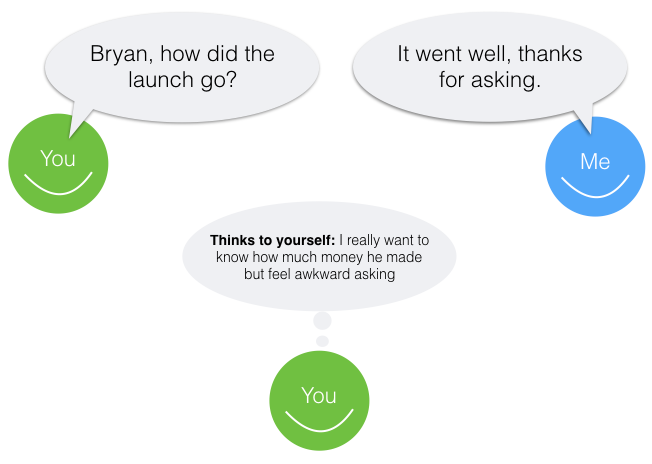
^^^ 50% of all conversations in the last 2 weeks. ^^^
So here are the numbers…
During the Spring launch we had 13,000 subscribers on the email list and launched to 11,500 of them. (More on why we excluded some people later.)
The results of that launch was $220,750 in invoiced sales.
Total new students: 234
…
During the Fall launch (the one we just concluded) we had 40,000 subscribers on the email list and launched to 22,000 of them.
The results of that launch was $511,466 in invoiced sales.
Total new students: 432
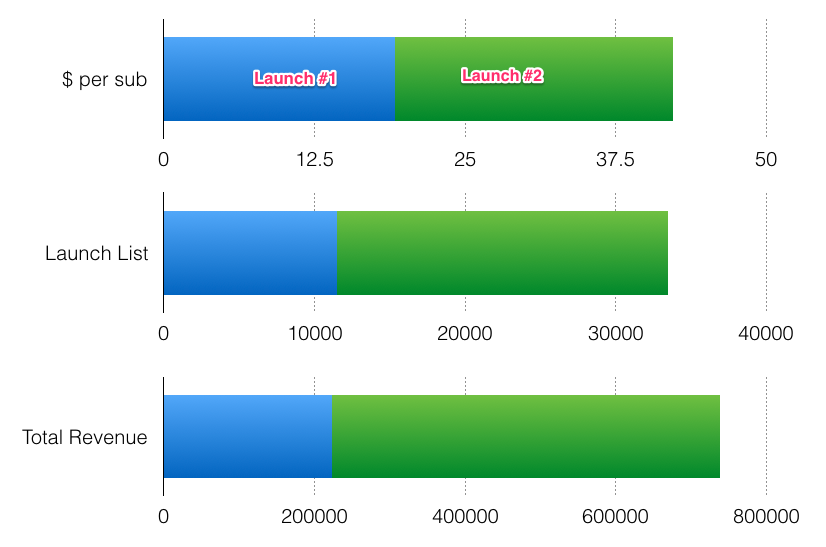
Here is the breakdown of who bought what.
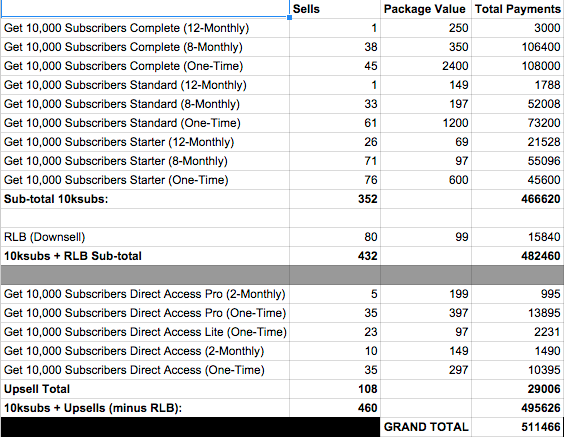
Heading into the 2nd launch of 10ksubs I was curious/worried/obsessed with how the second launch would go.
Would it be a one-hit wonder?
Would we make as much as we did the first time?
Would growing my list so quickly (tripling size) in such a short time period hurt the results?
I wasn’t sure what would happen, but I was 100% certain that the numbers would dip to some degree. Maybe not overall revenue, but I thought that the quality of the list would degrade as it grew.
I was wrong.
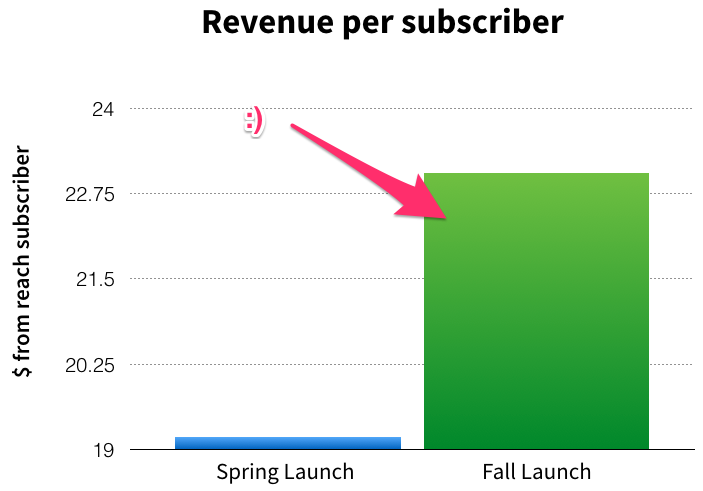
The revenue per email subscriber went up by 25%.
The average email subscriber in the Spring launch was worth $19.90.
During the Fall launch that rose to just over $23 per subscriber.
The average 10ksubs student during the Spring launch spent $1,064, whereas in the Fall launch that increased to $1,408 per student.
Why?
There were a handful of factors that contributed to that increase but the biggest was a change we made to the pricing of the course.
READ THIS SECTION (It’s really really important!)
Pricing is freaking important.
Most people tend to swing waaaaay too far one way or the other on pricing. Either they price their products 10x lower than they should because they are scared no one will buy (usually the result of a very primitive sense of what their market will pay) or they price 10x higher than they should.

When pricing your product the goal is to hit the sweet spot.
Not too high (or you’ll barely sell any and total revenue will suffer).
Not too low (or you’ll sell a ton but total revenue will still suffer).
Your goal is to be right in the middle. Swing too far one way or the other and the results can be drastic.
Imagine you create a widget…

And imagine your single goal in life is to figure out the perfect price for your widget.
You have a few options:
Option #1: You could sell your widget for $1 and get 1,000 people to buy from you.
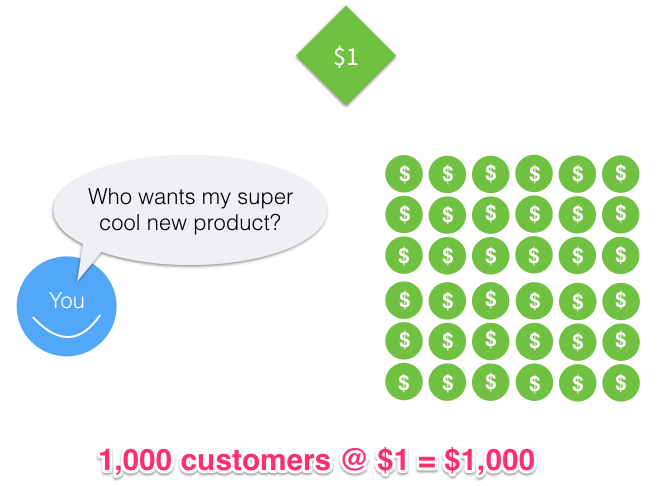
Option #2: You could sell your widget for $1,000 and get 1 person to buy from you.
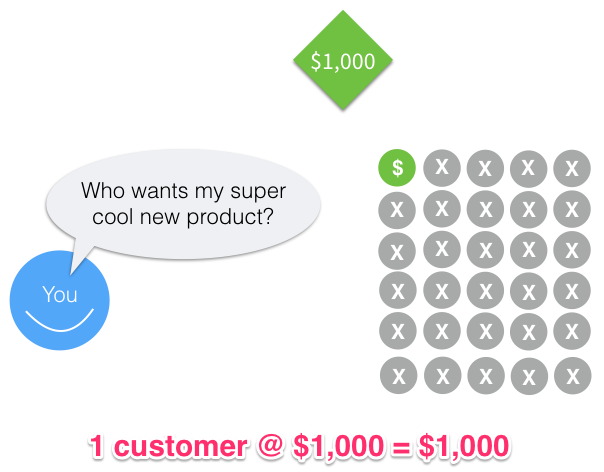
In the end you make exactly the same amount of money.
But what if instead of just randomly picking a price you found the sweet spot of $500 and were able to sell 100 widgets?
You would go from making $1,000 (because your pricing sucked) to making $50,000 (because your pricing was perfect).
The example might seem drastic, but it’s not. It happens every day.
It happened to me in this launch.
How to find the perfect price for your product
So, what do we do?
How are we supposed to find the perfect price?
First off, stop chasing the perfect price. I know, I just told you it was super important. But the problem with chasing perfection is it becomes a really fancy way to procrastinate on shipping your product.
Instead, give your product three different prices, then analyze who buys at each price and adjust so that your highest-priced version accounts for 15-20% of sales.
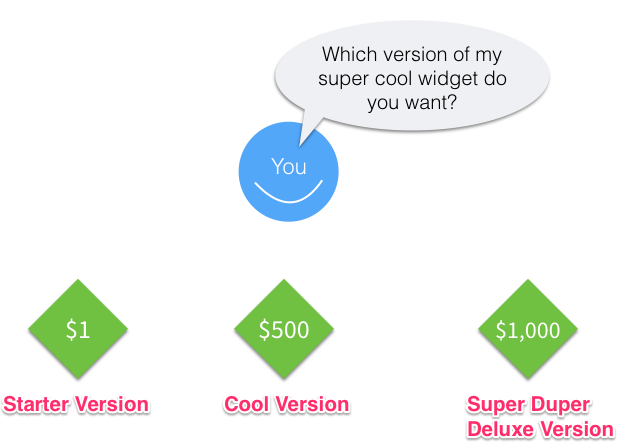
This small little tweak made us over $100,000 in the Fall launch.
Here is the step-by-step of exactly what we did…
In the Spring launch (remember, this was the very first launch of the product) we had two packages for the course:
Package #1: Master Plan that cost $1,200 (or 8 payments of $197)
Package #2: Pro Plan that cost $600 (or 8 payments of $97)
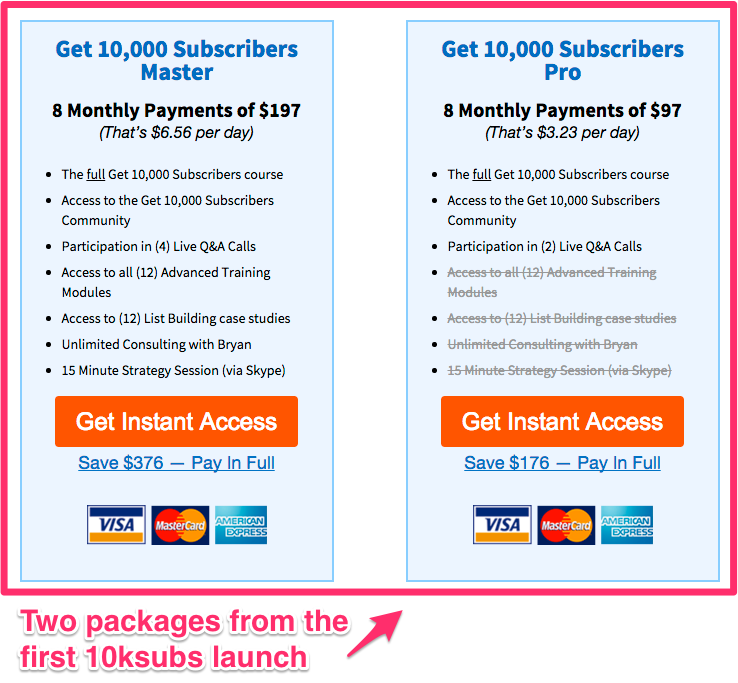
We decided on these prices by mixing one part “scientific testing” and two parts “stick your finger in the air and see what feels right.”
(You can read a full rundown of the validation process we went through that helped us get in the right ballpark in the Spring launch recap post.)
The results (remember, this is from the Spring launch of 10ksubs):
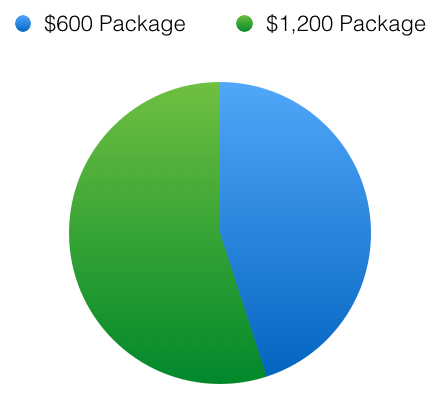
The results were that 55% of students purchased the $1,200 package and 45% of students bought the low-end package.
Ideally, you don’t want any more than 20% of your sales coming from your most expensive package.
If you have more than that, it means your price is too low and you’ve missed the sweet spot.
(Remember, missing the sweet spot is very bad.)
And we had 55%(!!!) of our buyers buying the high end package. If you are thinking to yourself, “That’s great! That means people really wanted the high end package!”, hold that thought until you see what happened in our latest launch.
Ok. So let’s summarize real quickly.
Summary Point #1: The first launch of 10ksubs brought in 195 students.
Summary Point #2: Those students either bought a $600 package or a $1,200 package.
Summary Point #3: Having multiple packages is good because it gives your high-end customer the ability to spend more money and buy a more awesome version of your product.
Summary Point #4: A sign that you’ve priced your product correctly is that no more than 20% of your customers buy your high-end package.
Summary Point #5: 55% of people bought our high-end package (meaning we had priced it too low).
Make sense?
Good!
Alright, we entered the second launch knowing that we needed to increase our pricing. But instead of jacking up the price across the board we decided to simply add a 3rd package.
This is what the new pricing looked like:
Package #1: Complete Package that cost $2,400 (or 8 payments of $350)
Package #2: Standard Package that cost $1,200 (or 8 payments of $197)
Package #3: Starter Package that cost $600 (or 8 payments of $97)
Here is the full breakdown of the packages…
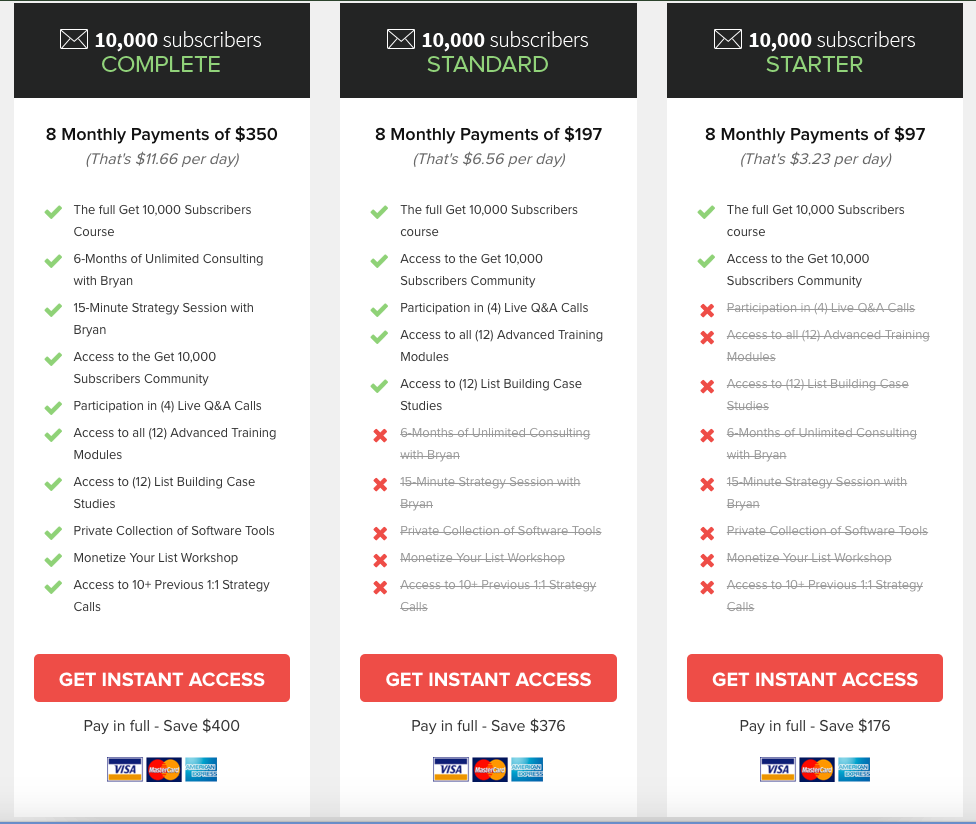
And check out what happened.
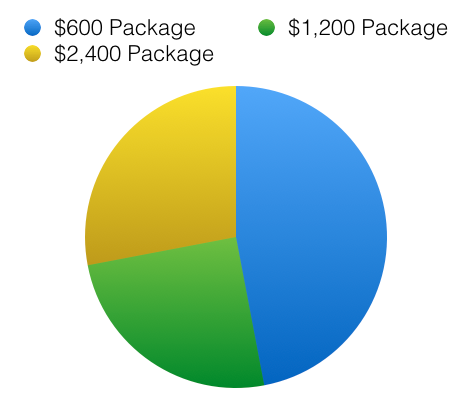
The number of people that bought the smallest package stayed practically the same (45% bought on the first launch and 49% bought on the second launch).
And the remaining 51% of buyers were split almost down the middle between the top two plans.
24% bought the $2,400 Complete package
27% bought the $1,200 Standard package.
Which means that without the addition of the $2,400 package, the 84 people who bought the Complete package would have almost certainly bought the Standard package (which costs $1,200 less).
That’s a $102,224 increase in sales.
…
..
.
Read that again.
Let it fully sink in.
By simply adding a third plan and giving people the ability to pay more money, sales increased by $102,224.
*mind = blown*
If we do a little math and extrapolate a bit, that means by missing the sweet spot (and NOT offering a third tier) in the first launch of the course, we left $64,800 on the table.
*mind = blown again*
This lesson is so incredibly important that I made a video explaining it a bit further.
WATCH THE VIDEO.
How can you do the same thing?
Action Item #1: Create three packages for your product.
Action Item #2: Analyze the buy rate of each package.
Action Item #3: If more than 20% of people are buying your highest package, adjust your pricing up.
Final note on pricing: Think of the tiered pricing packages as a validation mechanism first and a sales strategy second. First, you’re simply throwing out three different price points to see what your audience responds to the most.
If you use traditional single-tier pricing strategy, you have nothing to compare it to and simply have no idea if the response is good or bad.
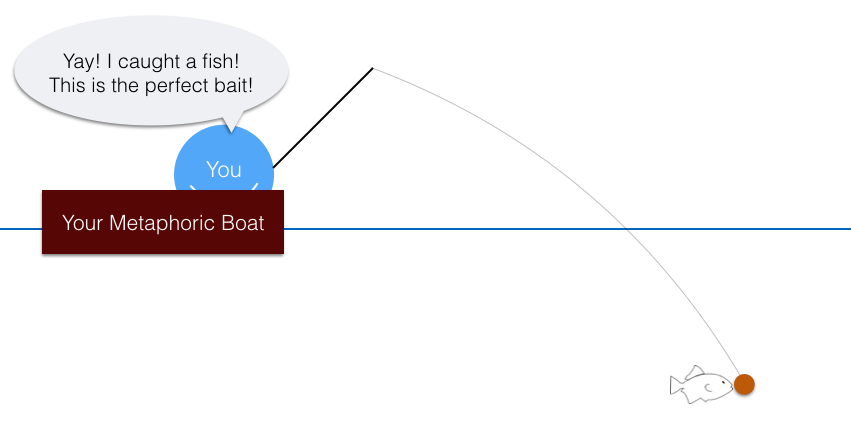
At the very least multiple price points gives you a baseline to judge the other packages off of.
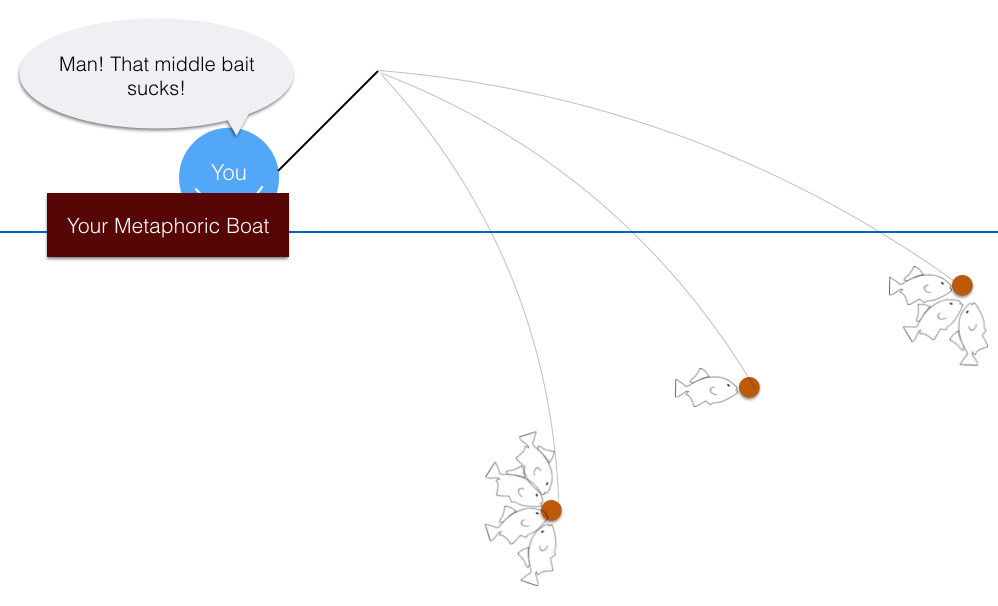
Part 2: How it all went down (the sequence of events)
Alright…
Now let’s back all the way up and go over the methodology and processes we used in the launch.
The teaching around launch scheduling and all the internal systems of how to do these launches really sucks. So, by the end of this post I want you to have a super-clear action plan for exactly how to do your next/first product launch.
I’ll give you that plan by giving an overview what we did and then boiling it down to a simple checklist you can use.
…
The Spring launch of 10ksubs nearly killed me.
I finished the course and the very next day started the launch process. 3 weeks and 40,000 words later the launch was finished. But I was a wreck.
Things needed to change for this launch. I couldn’t just wing it the second go around.
So, the very first thing we did was put together a launch schedule.
Here is what it looked like:
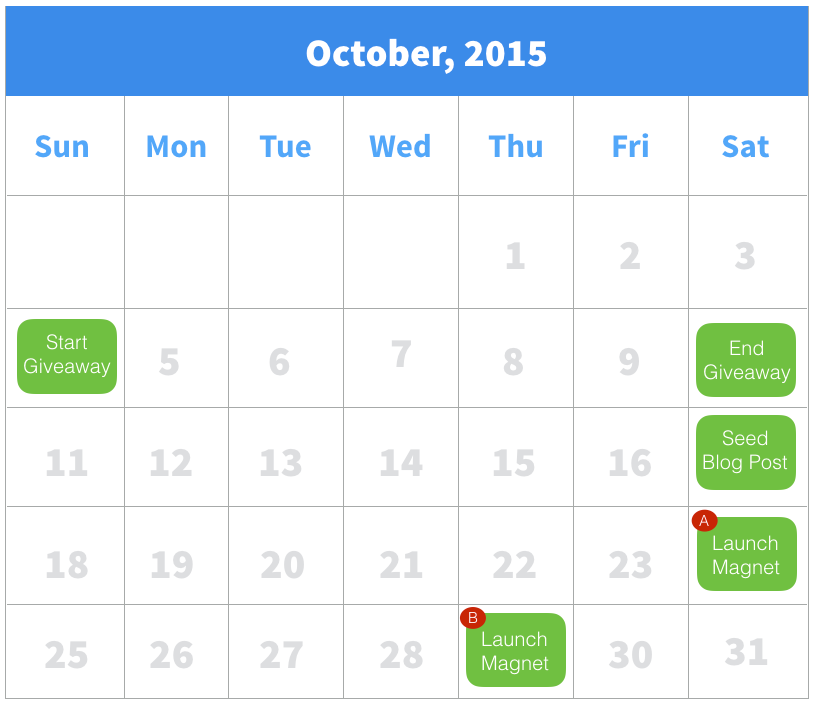
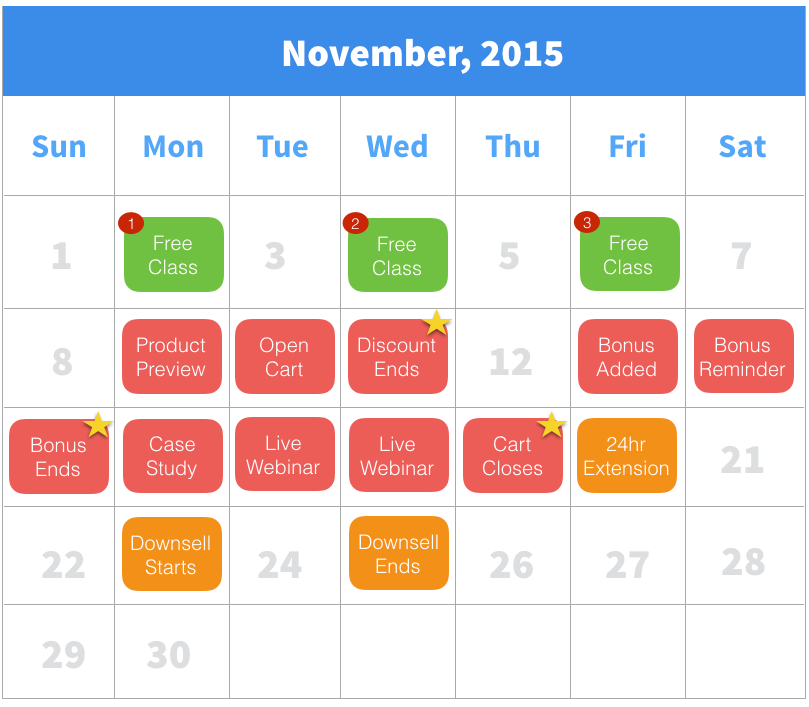
Our launch schedule consists of three major phases:
Phase #1: Before the launch
Phase #2: During the launch
Phase #3: After the launch
Let’s go over each one in detail.
Phase #1: Before the launch
The goal of your launch is pretty simple.
Get people to buy your product.
I’m sure you have noble intentions of saving the world, impacting lives and such but that all starts with a transaction (i.e.: someone paying you money for your product).
But that “paying me money for my product” part can be pesky.
If you want to convince someone to buy your product, you have to accomplish two things.
Thing #1: Make it a “my house is about to burn down and I have to get out” level of urgent that they fix the problem your product solves.
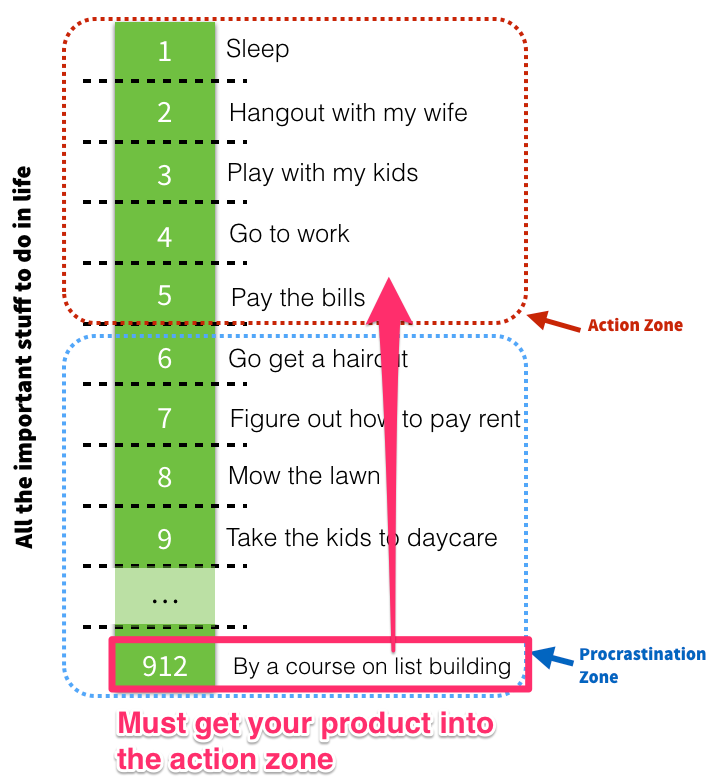
Thing #2: Make them extremely confident that the problem can be solved.
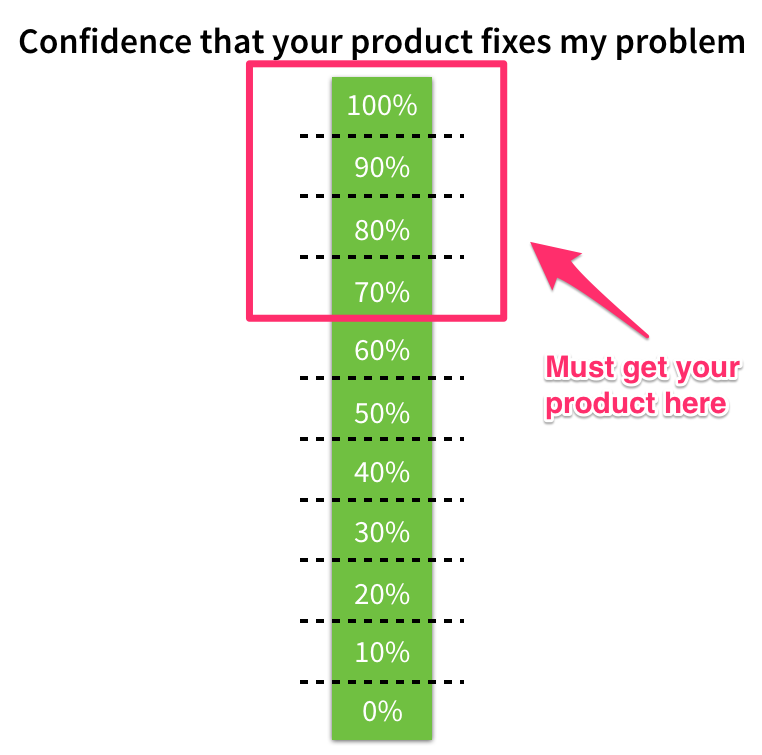
If it’s not urgent, I’ll never buy your product.
If I don’t think it’s possible for me to solve the problem, I’ll never buy your product.
But if solving the problem your product addresses is incredibly important to me and I’m 100% confident that your product is the solution, I’ll buy from you every time.
…
So, how did we do this?
We started the process 5 weeks before we launched the product. And we started by focusing on the problem our product solves.
I write about a lot of different topics on this blog: launching products, creating products, getting traffic, growing email lists, sales funnels and on and on.
But when we are selling our main course, the only topic that matters is list building (that’s the problem our product solves). The closer we get to the launch day the more hyper-aware we want the audience to be about that specific topic.
For example…
Imagine that you are selling a product that teaches your audience how to get stronger. And a few weeks before launch you write a blog post called “How to get strong for lazy people.”
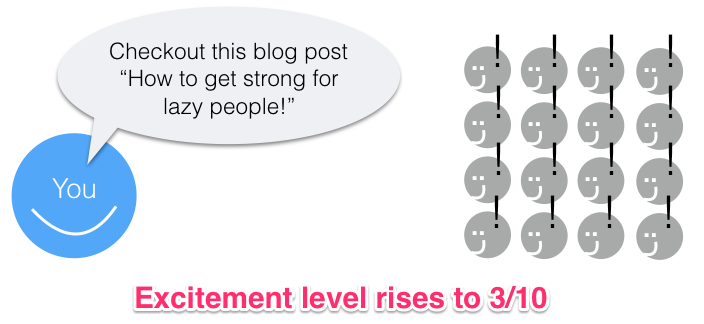
They read it. Dig it. And get slightly more excited about getting strong.
Then a few days go by and you do a giveaway for a year-long gym membership.
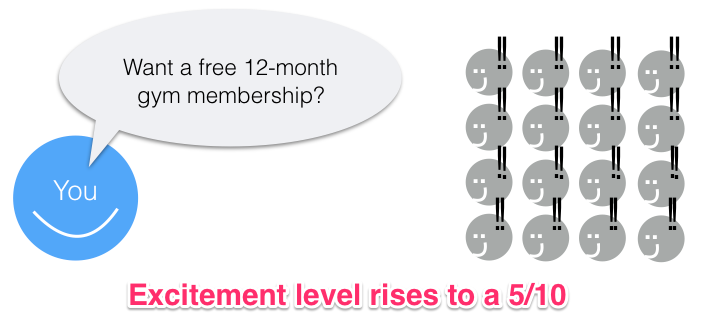
They see it. Get pumped up. And enter the giveaway.
But the next week you write an article on your favorite productivity hack.
As a result your list gets excited about solving their productivity problem.
Now you have competing interest. Some people get confused and start thinking they have a greater problem with productivity than strength training so they start looking for a product to solve that problem.
Meanwhile your strength training people are still excited up about that topic, but the shift in subject decreases their excitement level back down to a 3 out of 10 (from a previous high of 5 out of 10).
By focusing on the topic that your product covers, you prevent this issue, and instead of creating competing interests, your list becomes hyper-aware of the one thing you want them to be focused on.
…
The key to properly setting up your launch is staying focused on the topic of your product.
There were four main pieces we used in this launch to do that:
Piece #1: The Product Giveaway
Piece #2: The Seed Blog Post
Piece #3: The Launch Magnet
Piece #4: The Free Class
Let’s take a look at each one in depth:
…
Piece #1: The Product Giveaway
In this launch we kicked off the Before the Launch phase with a huge product giveaway:
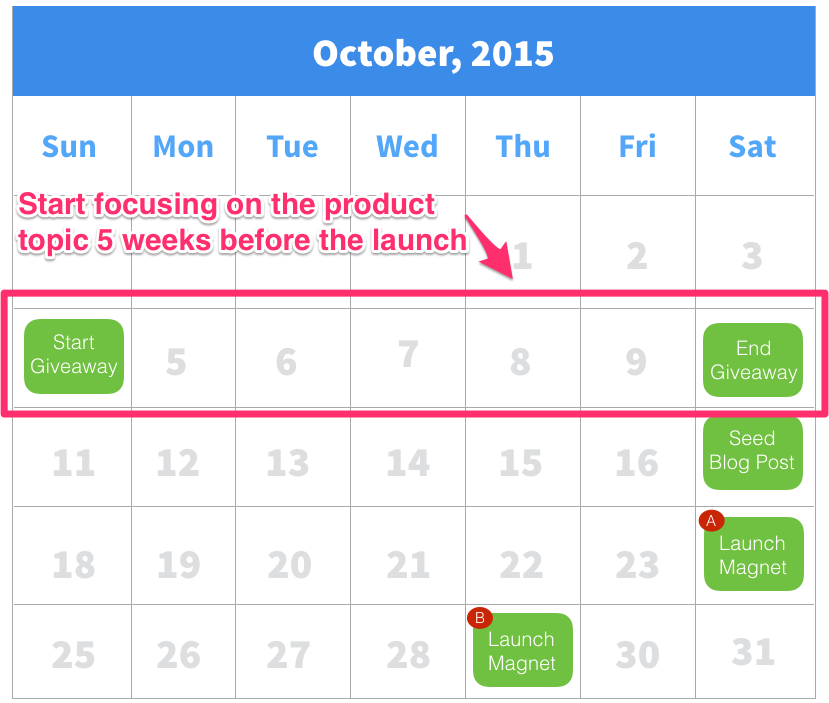
The giveaway was for a one-year subscription to LeadPages and all 300+ landing page templates in their marketplace.
(For a full step-by-step process on how to host your own giveaway, go here.)
We picked this as the giveaway prize because it is: A) a product that falls squarely inside of the topic of list building; and B) last year’s LeadPages giveaway did really well so it seemed smart to do it again.
My goal was to generate 7,500 opt-ins to the giveaway.
We failed. Miserably.

The goal was 7,500. We got 2,232.
(By comparison, last year we had 9,000 subscribers on the list and got right at 2,300 contestants in the giveaway.)
A few theories of why it sucked so bad:
Theory #1: The “prize was too technical” theory: Although the LeadPages giveaway worked well last year, my audience has shifted to include a larger percentage of beginners than last year. That could have caused the giveaway itself to be the equivalent to trying to get my grandmother to be excited about the new iPhone 6s (she just doesn’t get it).
Theory #2: The “poor job of describing the benefits of LP” theory: My other theory is that I did a poor job telling everyone WHY they should want a year of LeadPages and all the templates in the marketplace. It makes perfectly good sense to me, but for someone just starting out or someone who has no idea what LeadPages is, perhaps it wasn’t as clear. Classic case of talking too much about features and too little about benefits.
Although we failed at hitting our new subscriber goal with the giveaway, it’s important to reiterate that the primary intent of the Before the Launch content is to make your EXISTING LIST hyper-aware of the topic that your product covers.
That goal was absolutely accomplished.
A few interesting numbers:
Interesting Number #1: An existing subscriber who entered the giveaway was 11x more likely to buy the course than someone who didn’t enter the giveaway.
Interesting Number #2: A new subscriber who joined the list because of the giveaway was 7x more likely to buy the course than the average subscriber.
Interesting Number #3: Overall we can directly attribute $25,642 in sales to people who joined the list from the giveaway and bought the course.
One last thing about the giveaway…
Last year we paid out of pocket for the giveaway. This year I had the bright idea of contacting LeadPages and asking them to donate the prize.
This is the email I wrote (this was after a short Skype call with a new acquaintance who works at LP):
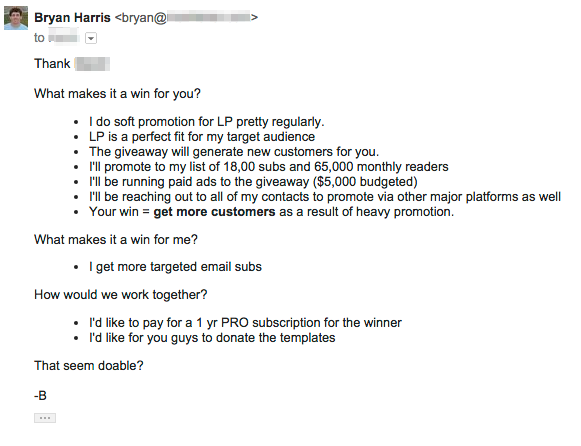
After a little negotiating back and forth they decided to throw in the annual subscription plan and all bonuses in exchange for a co-hosted webinar with my audience. (You’ll be seeing a few emails about this in January.)
I’d highly recommend reaching out to the owner of the product you give away and ask them to donate the product.
For some silly reason I didn’t do that during my first giveaway and it resulted in me paying for the entire thing out of pocket.
Send the email. Worst-case scenario? They say no.
Piece #2: The Seed Blog Post
Week 1 of the Before the Launch phase was the product giveaway.
Week 2 is the Seed Blog Post.
The Seed Blog Post works by teasing out one of the most attractive new features of your product in a dedicated blog post and then giving people who want that feature a special sign-up form (and eventually a dedicated launch email) to get that feature.
Here are the main steps:
Step 1: Identify one of the single coolest new bonuses or features you will include with your product.
Step 2: Write a blog post talking about it and teasing it up.
Step 3: Give a call to action at the end of the blog post for your product waiting list (and tag people who opt-in from this post).
Step 4: During the product launch itself, call special attention to that bonus/feature and give people from step 3 a special invitation.
Here is how we executed that…
First, we added in a cool new resource to the Complete Package of the course called Plinko. Plinko is a new piece of software that we are developing and currently run on this site. It allows people to grow their email lists more quickly by always giving visitors to their sites new offers (instead of seeing the same e-book or video series call to action over and over again).
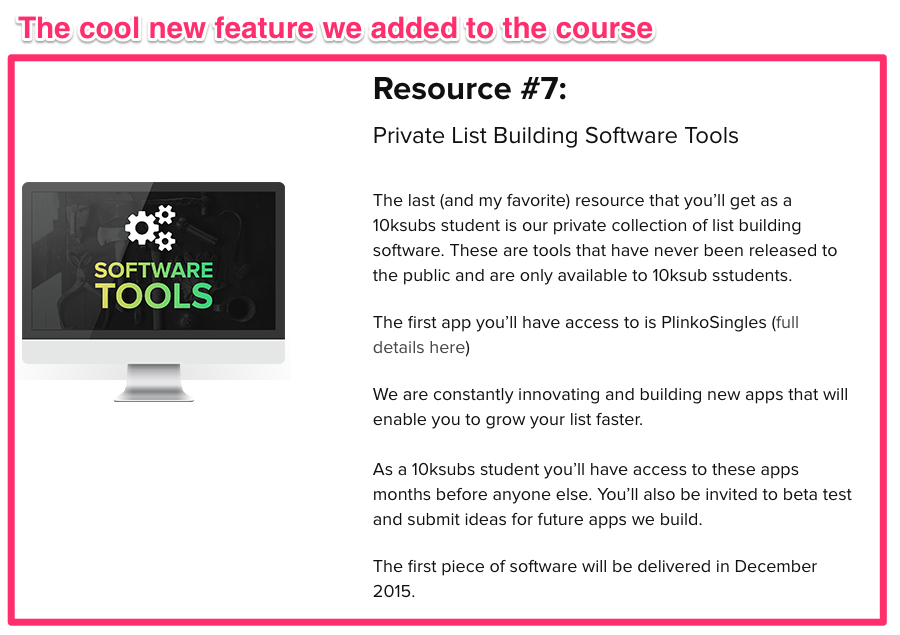
Then I wrote a dedicated blog post talking all about it, describing my vision for the product and showing the insane results we’d been experiencing with the alpha version.
At the end of that blog post we announced that we’d be releasing Plinko only to people who bought 10ksubs. Then we gave folks an easy way to get on the waiting list.
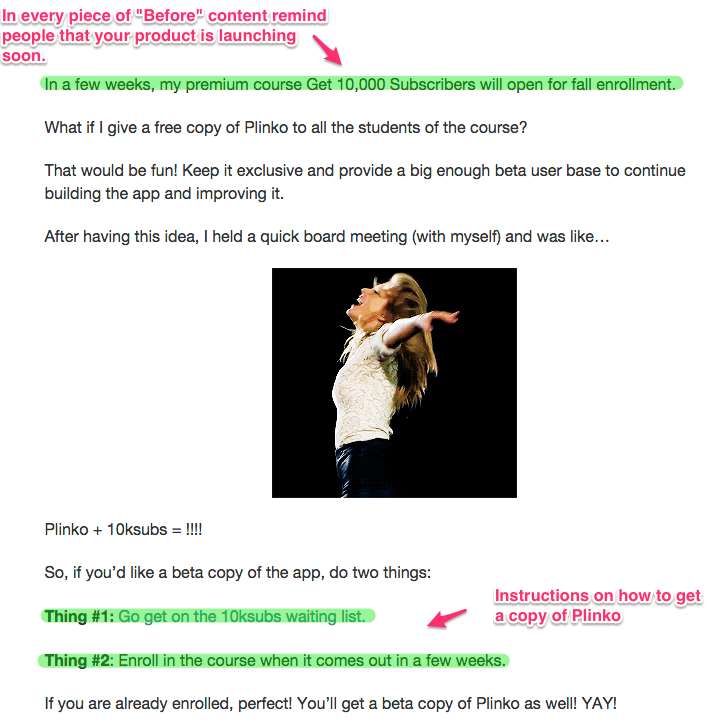
Lastly, on opening day of the launch we reminded everyone who signed up on that waiting list about Plinko and gave them personalized instructions on how to get it.
The results? Those that opted into the waiting list from this blog post were 6x more likely to buy 10ksubs than those that didn’t. Also, those that opted in were 3x more likely to by the Complete package (the package that included the special bonus).
Piece #3: The Launch Magnet
The third piece of Before the Launch content is the launch magnet.
The primary purpose of the launch magnet is to overtly prepare your list for your product launch, establish and reinforce your authority on the topic by positioning you next to other known experts and to identify the people in your audience most likely to buy your product.
My coach, Stu McLaren, told me to do this. So I did. And it worked really well.
This is how a launch magnet works:
Step 1: Produce a big piece of content built around the advice of 10-20 experts on the topic that your product covers.
Step 2: Use Facebook ads to target the audiences of the experts in your launch magnet.
Step 3: Reach out to each expert and ask them to share the launch magnet.
Step 4: Share the content with your audience via email and a blog post.
First we picked the medium that we’d use for our launch magnet. We chose an e-book, but you could do a virtual summit, e-book, webinar or any number of things. We chose an e-book mainly because we were running behind schedule and it needed to be something we could put together in 2 days.
Next we came up with a snazzy title and cover for the e-book: “Top 16 List Building Strategies for 2015.”
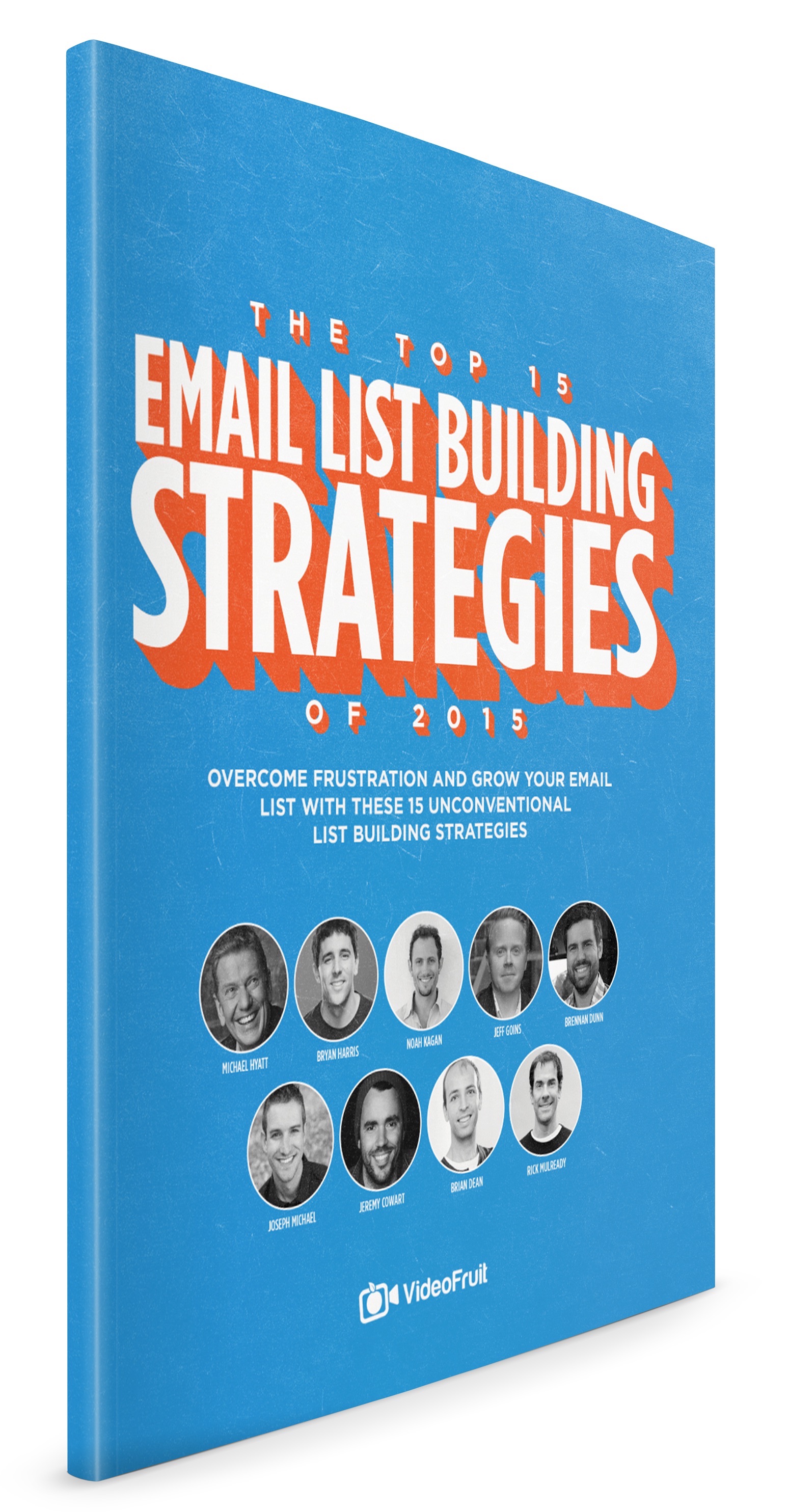
To create the content for the book, I pulled up an internal Evernote file that I keep updated with cool list-building techniques that other people are using. In a matter of 60 minutes or so, I threw together a Google Doc that listed each strategy, with a short description and steps to implement it.
This is what the inside of the e-book looked like when finished:
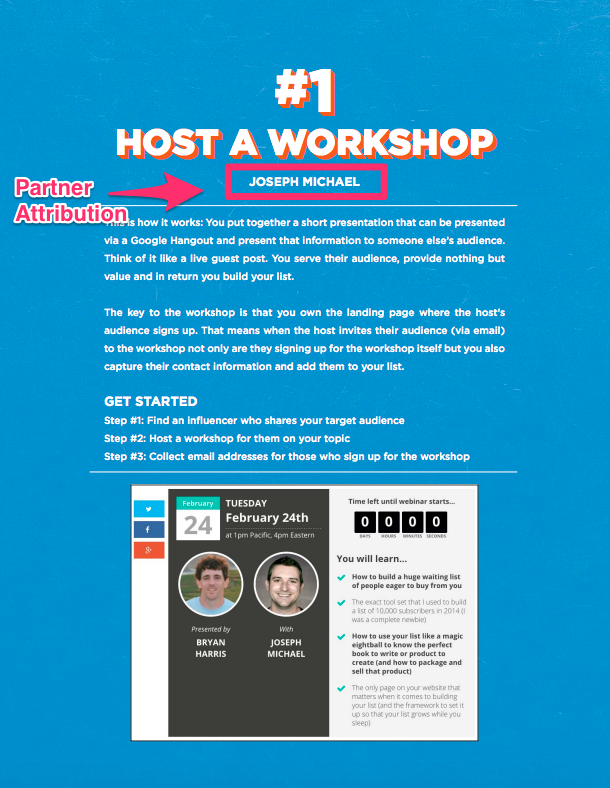
Then I strategically found one person to attribute each strategy to.
We’ll talk more about this later, but one of the big improvements we made in this launch was adding in a partnership program where other people could promote the course and get commissions based on how much they sold. The e-book was a great recruitment strategy for those partners.
Basically, it worked like this:
- Highlight people in the book who had committed to promoting the course.
- Highlight people in the book who we wanted to promote the course.
- Tell them we included them in the launch magnet.
- Cross our fingers that they’d be super pumped they were included and as a result promote the course more.
That strategy panned out well. Of the 16 people featured in the book, 6 became partners, and they directly accounted for over $100,000 in sales. (More details on partnerships later in this article.)
Once we had created the e-book and shared it with each person featured, we then set up Facebook ads to target the audiences of those folks.
Here is one of those ads:
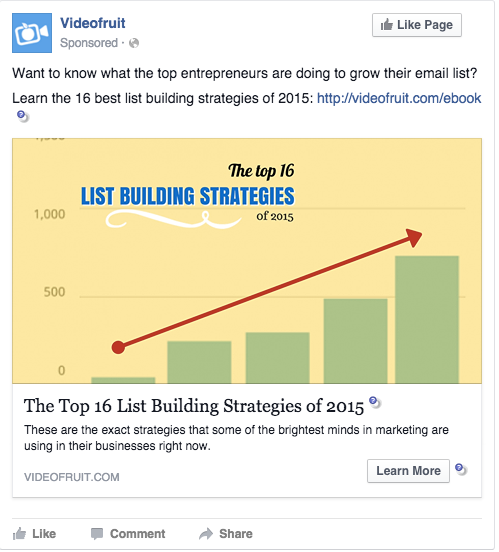
The results? 253 people became email subscribers and we spent $640 total on ads to get them (for $2.53 per sub). Of those 253 new subscribers, 12 became customers and accounted for just over $15,000 in sales.
The last piece of the launch magnet is sharing it with your audience.
We shared it with the Videofruit audience by emailing them about it twice and also publishing a blog post.
Here is what the first email we sent:
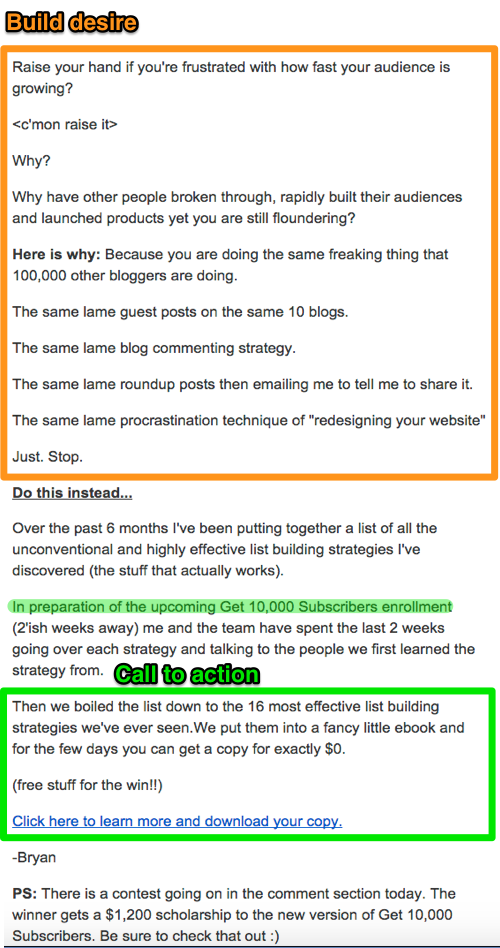
Here is the second email we sent:
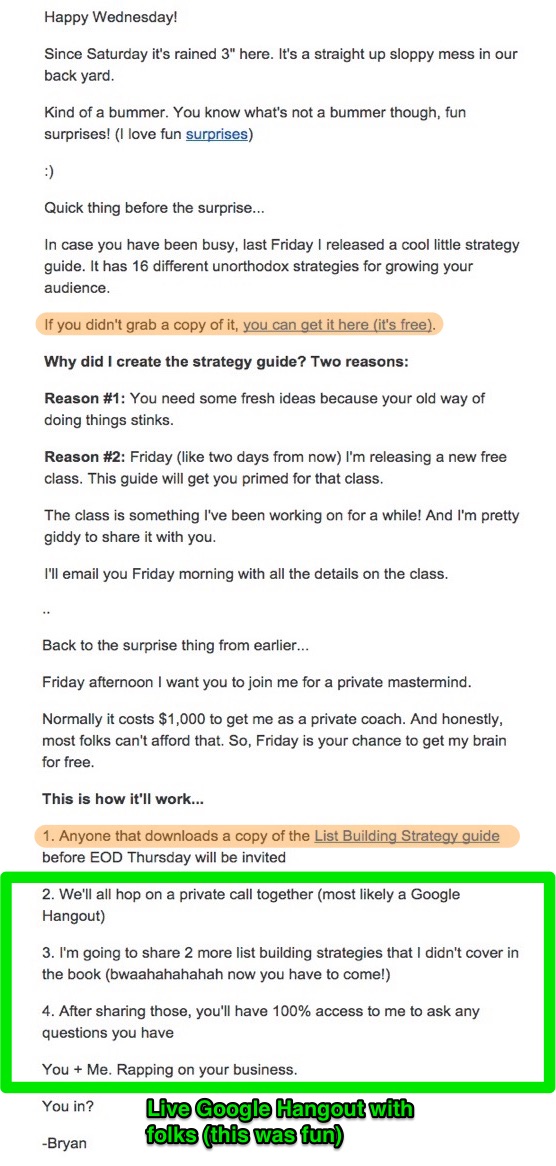
In total 10,288 people downloaded the e-book.
The results? People who downloaded the e-book were 5x more likely to buy the course than those who did not.
Piece #4: The Free Class
Let’s review where we are at before we keep trucking along…
There are three major phases to launching a product:
1) Before the launch
2) During the launch
3) After the launch
Currently we are focusing on the Before the Launch phase.
The primary goal of the Before the Launch phase is to remind people that they have a problem by focusing on that problem in the 5 weeks leading up to the launch, make it incredibly urgent that they fix the problem and to leave no doubt in their mind that the problem can be solved (with a little help from your product).
Then we outlined the 4 pieces of the Before the Launch phase.
Piece #1: The Product Giveaway
Piece #2: The Seed Blog Post
Piece #3: The Launch Magnet
Piece #4: The Free Class
So far we’ve covered pieces 1 through 3. They have primarily focused on the first intent of the Before the Launch phase (reminding of the problem and focusing attention on it).
The fourth and final piece, the Free Class, will focus on making it urgent and increasing each person’s confidence in solving the problem.
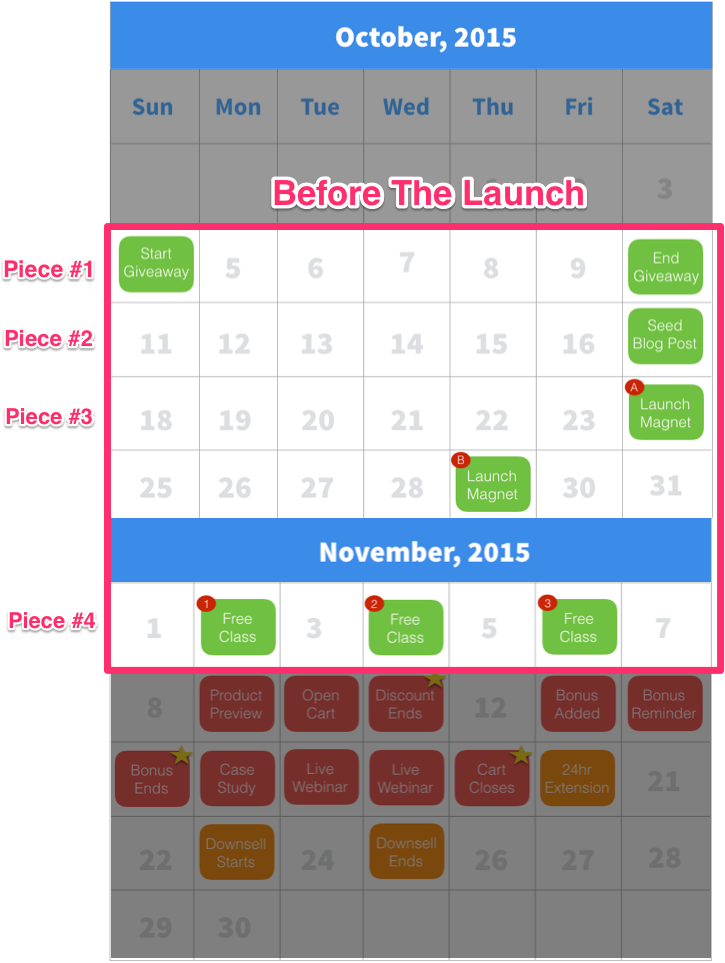
Our Free Class consists of three video-based lessons that were sent out on Monday, Wednesday and Friday.
Each of these lessons is strategically created to fit into the PAS formula.
Here is a quick refresher on PAS (if you missed it in the Spring):
Each lesson was video-based, hosted on a ClickFunnels landing page and emailed out to the list.
We also set up a opt-in page that we could use to promote via paid ads and universal calls to action on the Videofruit site.
Here is what that opt-in page looked like (zoom in):
Here is what an individual lesson page looked like (zoom in):
The outline of the free class:
Lesson #1: (Monday) Introduced the problem (with a personal story)
Lesson #2: (Wednesday): Agitated the problem (by telling them what not to do)
Lesson #3: (Friday): Solved the problem (by giving them one small quick win)
We put together the video scripts based off of the emails we wrote in the Spring launch.
For example, here is the Lesson #1 email from the Spring launch (zoom in):
And here is the Lesson #1 video from the Fall launch:
They are nearly identical scripts with a few different stories interjected.
I’d highly advise sticking to a text-based launch for your first launch and then using those emails to create a video-based class the second time around.
Additional Note: One major advantage of text to video is that there is practically zero barrier to consuming the information in a free text-based class. Just open the email and read.
However, in a video-based class you have to open the email, read the email, click a link, load a page, click a video play button and then linearly watch a 15-min. video. That’s A LOT more friction.
The personal investment is higher, so the people who are super-engaged are much more likely to buy from you after watching, but the sheer number of people who watch as opposed to read an email is much lower.
We noticed this after we sent out Lesson #1 of the class. So we adjusted course and the next day we emailed a text-based version of the lesson to everyone who didn’t click the video link in the original email.

The open rates and replies with “Thank you for sending this!” rates were very high on these.
I’d advise you do the same.
The results from the class?
• We had 24,300 total views of the free class videos.
• We had just over 700 total comments on all the lessons.
• Someone who read or watched the free class was 16x more likely to buy the course than someone who didn’t.
Side note: Segmenting to high-interest groups
All four pieces of the Before the Launch content were used to segment our email list into two parts.
Part #1: Highly interested people
Part #2: Not really interested people
This is how it worked: Anyone who entered the giveaway, joined the waiting list on the Seed Post, downloaded the e-book or engaged with the free class had a tag applied to their contact record as being highly interested.
Then during the launch itself, we emailed and communicated with them more aggressively than people who had expressed no interest.
The highly interested folks got 1-3 emails per day during the launch.
People who weren’t really that interested got much less email.
…
One important thing to keep in mind about your list is this…
2-5% of your list is ready to buy anything you sell them at any given time.
The other 95-98% of your list needs a little foreplay to get them ready.
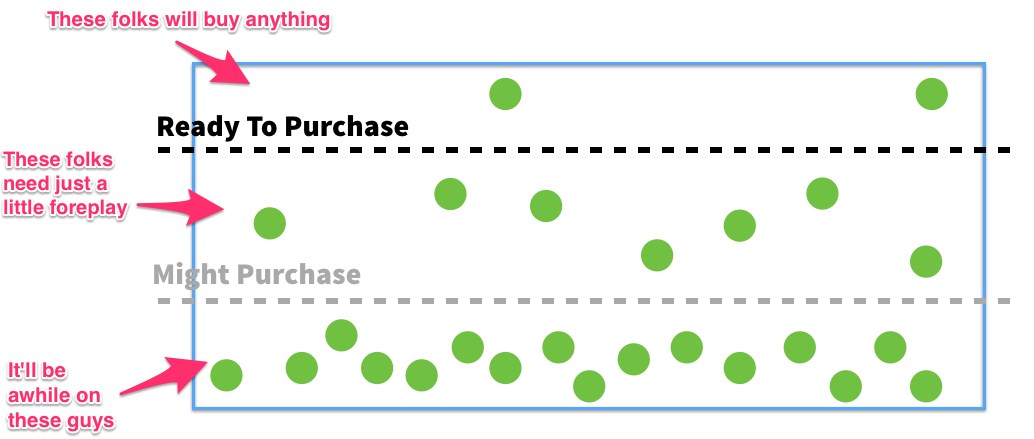
(Credit to Derek Halpern at Social Triggers for originally coming up with the concept for this visual.)
During most product launches I’ve seen, everyone below the Ready to Purchase line was ignored.
This is a critical error.
If you use the Before the Launch strategy I laid out above, you’ll get the majority of that middle group and a decent percentage of the bottom group to move above the Ready to Purchase line.
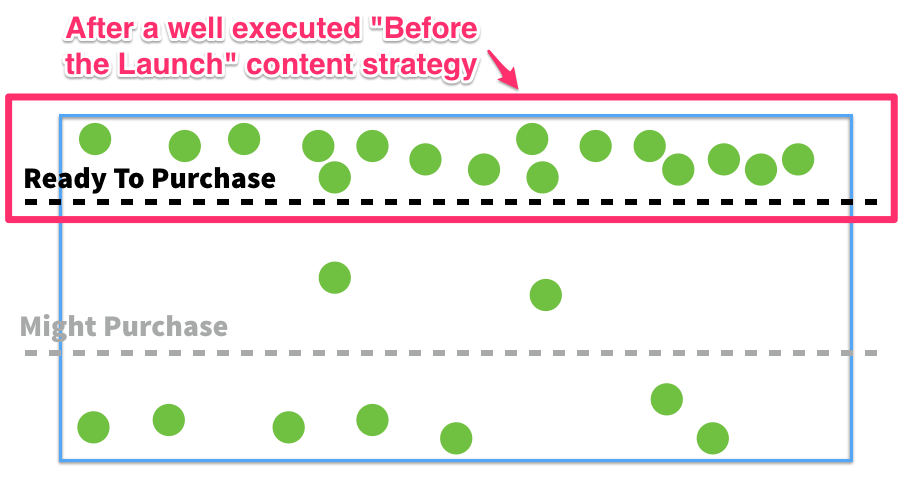
Phase #2: During the launch
After 5 weeks of prep work, we were ready to launch.
While a TON of work is done during the first phase, the During the Launch phase is critical.
This phase is broken into three main pieces:
Piece #1: First 72 Hours
Piece #2: Mid-Launch Push
Piece #3: The Home Stretch
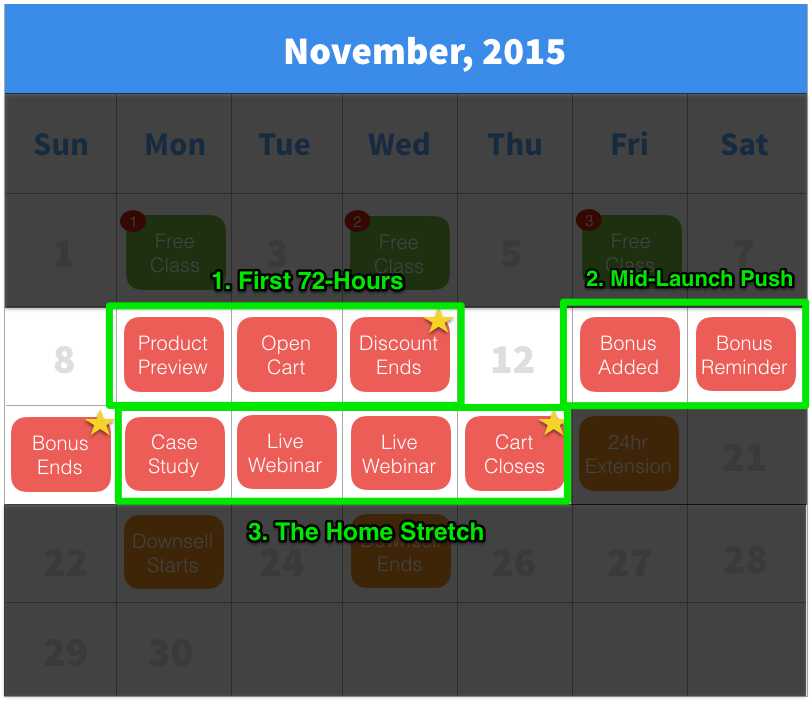
Let’s walk through each piece step-by-step.
Piece #1: The first 72 hours
The first 72 hours piece of your launch covers the day before you open the cart, the day of the open cart and the day after.
We sent 4 emails on these 3 days.
Email #1: The Product Preview Email: This email ties back into the last lesson of the course, introduces the course, positions it as a way to fully solve the problem discussed in the free class and tells them that it will be available to purchase tomorrow morning.
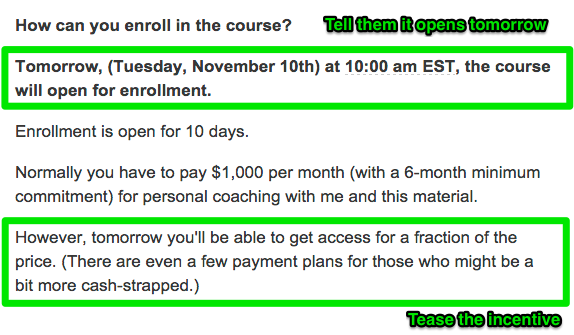
Email #2: The Open Cart Email: This email is very basic. It announces the cart being open and gives an incentive to purchase in the first 24 hours.

Note: In the first 24 hours of the cart being open, we heavily incentivize people to buy the full pay plan of the course. We do this for a few reasons. Our best students are the people who buy in the first 24 hours (lowest refund rates, least complaints, etc.). If you think back to the “Ready to Purchase” graph in the previous section, this makes sense. I want to reward those students and capitalize on their excitement to generate as much cash in hand as possible.
As the launch goes on, more people tend to opt for payment plans, which is great, but also puts a strain on cash flow and decreases the likelihood that the full price of the plan will ever be collected.
Email #3: The Extra Incentive Email: We sent this email at 3 PM the day of open cart, announcing a new bonus that we added for folks who purchase in the first 24 hours of the cart being opened. For this launch, that extra incentive was a copy of Brennan Dunn’s course “Double Your Freelancing Rate,” whcih he normally sells for $300.
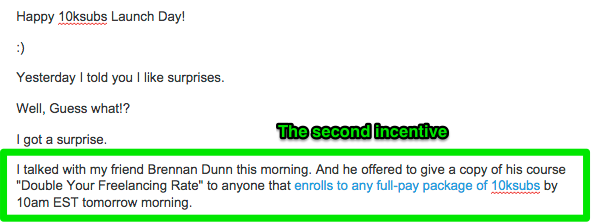
We worked out a deal where he gave us the course for no cost in exchange for me giving him my $200 course for no cost as a bonus in his launch.
Email #4: The Incentives are Disappearing Email: This email has one purpose. Get people to act now. It simply reminds folks that the 15% discount and the extra incentive (Brennan’s course) are going away.
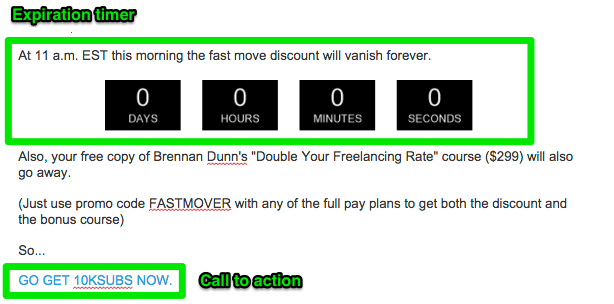
The results…
In the first 24 hours of the launch (from 10 AM CST to 10 AM CST) we generated $125,000 in sales.
Here is the hour-by-hour breakdown:
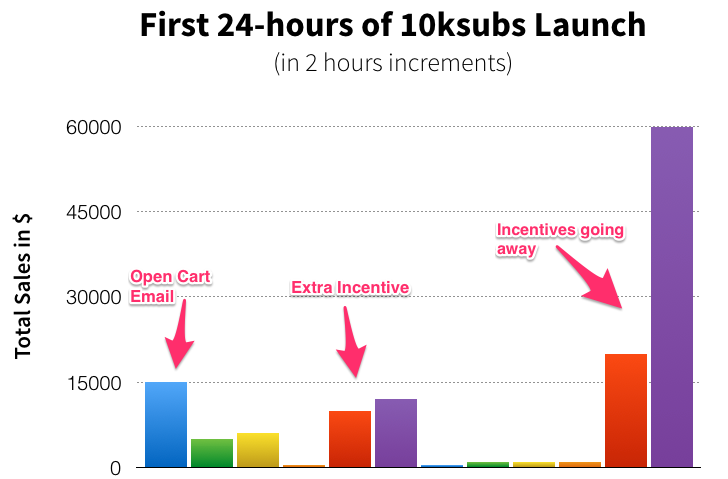
Piece #2: The Mid-Launch Push
If I’ve learned nothing else about launching products it is this: people make a decision to buy whenever they are about to lose something.
Notice the graph in the previous section…
See that the biggest spike in sales occurs in the 2 hours before the bonuses go away? That’s indicative of the entire launch process.
Whenever you can create true scarcity and urgency, people will pull the trigger and buy your product.
That is exactly why we engineered the launch schedule the way we did.
It creates three primary points of urgency.
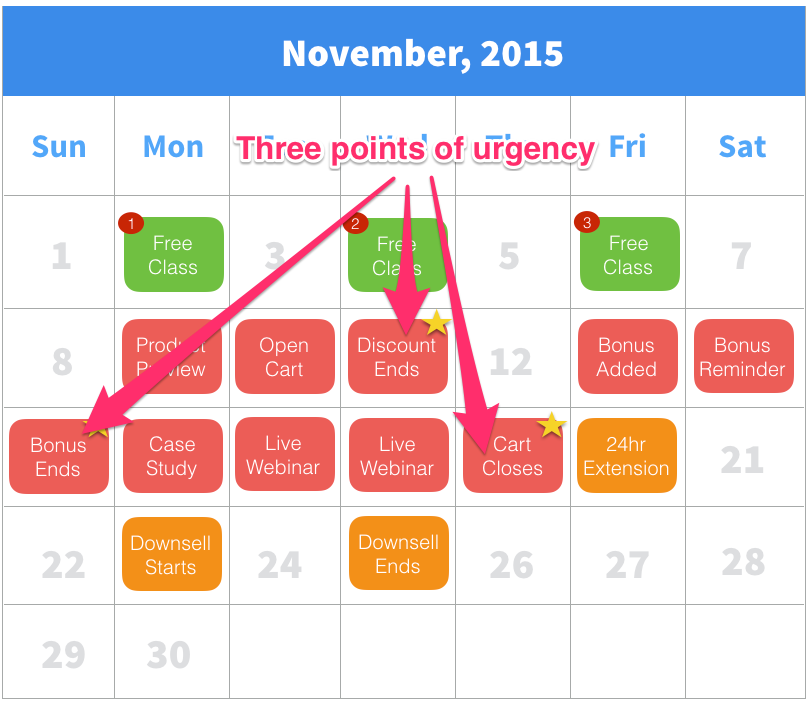
You just saw the first point of urgency, the 24-hour incentives expiring.
Now let’s take a look at the second point of urgency, the Mid-Launch Push.
This is how it works:
Step 1: Mid-way through a launch is usually the slowest part of a launch. We want to change that.
Step 2: So we introduce a new bonus in the middle of the launch.
Step 3: A few days after introducing it, we take the bonus away.
This causes a nice spike in sales.
Here are the bonuses we offered in the launch (click to zoom in):
We offered these bonuses through a series of 3 emails:
Email #1: Introduce the Bonus: In this email we introduce the bonuses to everyone who hasn’t bought the course yet.
Email #2: Bonus Reminder and Short Case Study: The next day we remind everyone about the bonuses and share a short case study of one previous student who used the bonuses and got a positive result.
Email #2: Last Call: Then on the final day of the bonuses, we send a last-call email 4 hours before the expiration of the bonuses.
The results…
In the first 72 hours of the Mid-Launch Push we generated $85,000 in sales.
Here is the day-by-day breakdown:
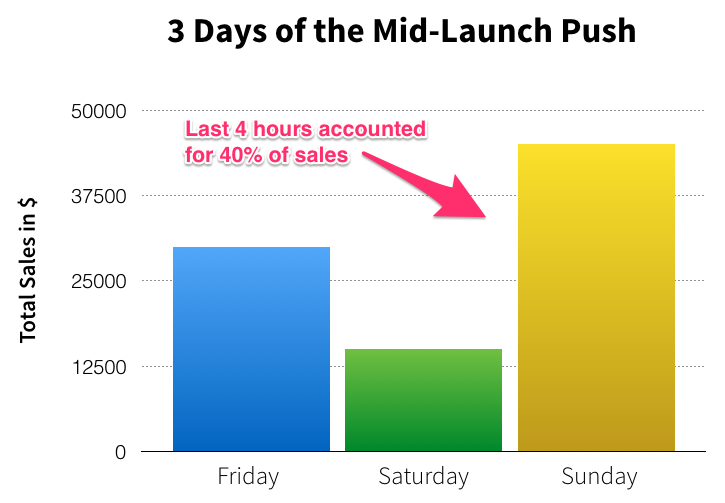
Piece #3: The Home Stretch
The last big piece of our During The Launch phase is the Home Stretch.
This is the time period of Monday through Thursday of the launch.
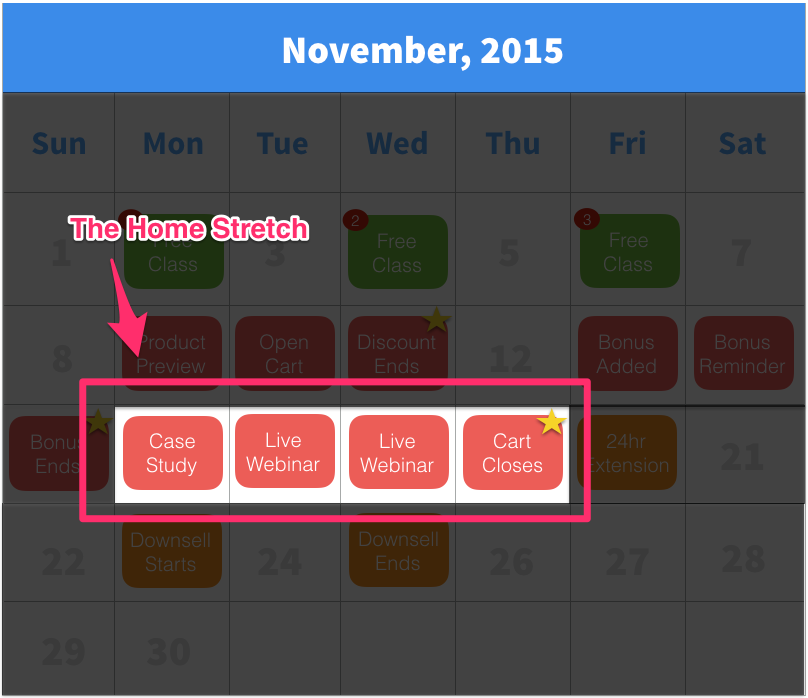
There are 2 primary parts of the Home Stretch.
Part #1: Live Webinars
Part #2: The Last Call
…
Part #1: Live Webinars
Webinars are something I had not experimented with as a selling mechanism until this launch. But leading up to the launch, every smart person I knew said I was crazy for not using them.
So I used them. 🙂
This is how they worked:
Step 1: We emailed everyone on the list and invited them to an educational webinar named ‘How to Get 1,000 Subscribers by February 17th, 2016.”
Step 2:: During the webinar I taught a ton of valuable free material (for about 45 minutes).
Step 3: Then I transitioned to a pitch for 10ksubs
Step 4: I offered a free bonus to everyone who purchased live on the webinar.
Here is a copy of the webinar if you want to check it out:
The first webinar we did generated right at $15,000 in sales live on the call.
That got me really excited, so we added a second webinar on Wednesday. That produced just over $30,000 in sales live on the call.
So…we added a third one! 🙂
We did the third webinar on Thursday night (cart close day) at 5 PM. And that webinar produced just under $50,000 in sales live on the call.
I could write another 5,000 words just on how to do these webinars, but that’s not the point of this post. So I’ll summarize with a few key points below.
A few lessons I learned from doing three webinars:
Lesson #1: Go buy Perfect Webinar from Russell Brunson. It’s a great framework on how to put together the content for the webinar.
Lesson #2: Go study what Mariah Coz is doing with webinars. Her numbers are off the charts. She’s super smart. (Buy her course if you’re serious.)
Lesson #3: Make sure you have an enticing bonus that is only available on the webinar (and that expires once the webinar ends).
Lesson #4: Don’t get caught up in what technology to use for your webinar. We used Google Hangouts (free) and Chatroll ($50). Keep it simple.
Lesson #5: Make sure you have a solid follow-up email sequence for your product offer. We emailed 2 hours after the webinar, the next morning and later that afternoon. This accounted for 30% of all webinar sales.
Part #2: The Last Call
The final piece of the During the Launch phase is the last call.
By this point we had sent 30+ emails to different segments of the list. It’s easy to feel like your list is spent, like it’s done, like no one will ever buy from you again.
But that’s a lie.
The last day is the most important day of the entire launch.
We sent three emails on the last day.
Email #1: Last Call with Case Study: This email goes out at 6 AM on Thursday. It contains a case study showing how one student grew their list and launched their first product and concludes with a call to action and timer reminding them that the course closes tonight.
Email #2: Reminder of the Transformation: The email goes out at 1 PM on Thursday. It walks them through the transformation process, showing them where they are at now and where they could be. This email is really important.
Email #3: The Last Call For Real: This email goes out at 7 PM on Thursday night. It is the last reminder that the cart closes in just a few hours.
The results….
The final 24 hours of the launch accounted for just over $200,000 in total sales (with 35% of that coming in the final 4 hours before cart close).
Phase #3: After the launch
I went into a ton of details on our post-cart close strategy in the Spring launch recap. (Feel free to bounce over there for full details.)
During this launch we generated another $45,000 in sales after the cart had closed.
Here is the gist of what we did to accomplish that:
Part #1: The Extension:
Step 1: Friday morning we emailed everyone who had clicked through to the sales letter but hadn’t bought.
Step 2: We offered them an offer for a 12-month payment plan that was good until end of day.
Step 3: At 7 PM that night we emailed them one last time, telling them it was shutting down.
Part #2: The Downsell:
Step 1: Monday morning after the launch we emailed everyone who didn’t buy with an offer for a $200 mini-list-building course.
Step 2: We kept the cart open for 72 hours.
Step 3: On Wednesday we emailed one last time with a final call to grab the $200 course.
A few things about this After the Launch strategy bothered me this go around:
First off, the numbers dipped significantly on the cart extension.
During the last launch we generated nearly 25% of total revenue during the cart extension. This time that dipped to 5% of total revenue.
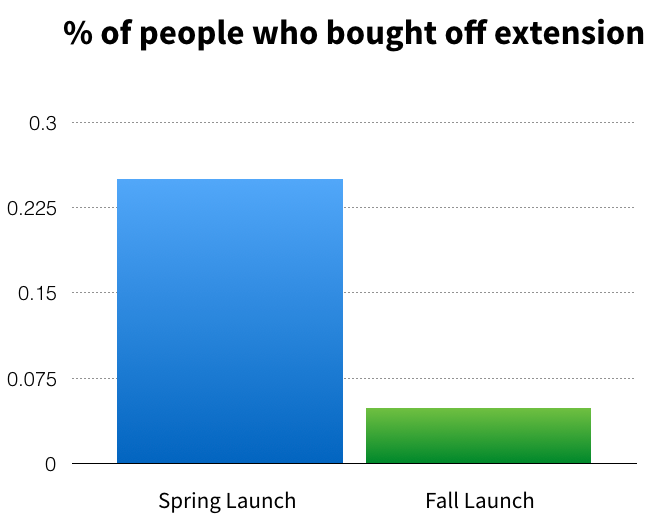
I really don’t have any idea why, but I was already mentally on the fence about the strategy to begin with. It feels a bit disingenuous to say the cart is closing but then to open it the next day to a select group of folks.
That gut feeling plus the poor results from this last launch pushed me to ax that strategy on the next launch.
…
The downsell, on the other hand, I’m a huge fan of.
It generated just over $15,000 in additional sales. While that isn’t a large percentage of total launch revenue (2.9%), the buy rate rose slightly from the first launch to the second.
Also, the number of people who bought 10ksubs during this launch who had bought RLB (the downsell product) during the last launch accounted for $25,000 in revenue.
With a better downsell product and improved sales funnel for them to upgrade to 10ksubs, I believe we could significantly improve that percentage in the Spring launch.
Your Action Plan for Launching
Alright, if you’ve read this far you now have a solid understanding of the overall concepts and the major elements of how we launched 10ksubs (and how you can do the same).
But honestly, what you just read is hard to use.
What I’ve always wished existed is a checklist that we could refer to each time we got ready for a launch. Something we could follow to make sure we got all the big pieces of the launch in place.
Something to ease my mind, allow me to plan everything out and not be completely overwhelmed.
So, I spent the last few days compiling a few disjointed old checklists we have, talking to the team and reaching out to several friends that routinely launch courses. And what I came away with is a fairly comprehensive checklist you can follow and me and my team will be using for the Spring 2016 10ksubs launch.
It’s not intended to include every menial task associated with launching, but rather to make sure all of the big pieces of your launch are in place.
Also, keep in mind that this is v1.0. We’ll continue to update it and add to it as we go.
The checklist is divided into three primary sections:
Section #1: Before the Launch
Section #2: During the Launch
Section #3: After the Launch
Part 3: How we used Facebook ads during the launch (our overly simplistic strategy)
One major new element we added into this launch was paid advertising.
I’ve only dabbled in PPC in the past and certainly wasn’t up to running a full blown campaign during the middle of a launch.
But after asking around, I got a referral from a friend to a really good PPC guy that could manage it all for me.
So, most of what you see below was implemented by Tony (the ppc guy) through minimal collaboration with me.
Let’s start with the results:
We spend $1240 on Facebook ads.
We made $46,464 from those ads.
That’s a 36x return on the ad dollars.
Now let’s look at what we actually did:
We tried 3 different strategies with the ads.
Strategy #1: Try to get peopel that don’t know us to signup for our list then buy the course
Strategy #2: Try to get people who had visited my site to signup for a webinar (where we would then sell them the course)
Strategy #3: Try to get people who had visited the sales or checkout page to come back and buy the course
..
Strategy #1 Breakdown
The first strategy worked like this:
- Identify interest groups on Facebook that would probably be interested in growing their list
- Run an ad to them getting them to download a free ebook on list building
- Then try to sell them the course
This is the highest performing ad we ran:

Across the entire campaign for the guide, we generated 253 email subscribers at a cost of $2.53 per conversion.
But…not a single one of them bought. Bummer.
Why didn’t it work? Our best guess is that people that have no idea who we are need a little more warming up before they are ready to buy a $600 course.
However, it’s hard to draw any conclusions as the sales page had yet to be created when this was promoted and that could potentially have caused tracking issues.
Strategy #2 Breakdown
The second strategy worked like this:
- Show an ad to people that had visited the Videofruit website in the past 6 months
- Try to get those people to signup for a webinar
- Once they were on the webinar: Teach them stuff and then sell them the course
This is the highest performing ad we ran:

Across the entire campaign for the webinar, we generated 127 email subscribers at a cost of $0.29 per conversion.
Some of our tracking went haywire on these so we recorded no sales.
However, the ads were shown to warm leads (people that were at least knew that VF existed) so the cost per lead was extremely low.
Next go around we’ll shore up our tracking to be able to report the exact sales that this ad set produced
Strategy #3 Breakdown
The third strategy worked like this:
- Show an ad to people who had visited the sales page or checkout
- Remind them to come buy the course
This is the highest performing ad we ran:

The results of this strategy? 33 people who clicked on the ad, bought the course.
Those 33 people accounted for $46,464 in sales.
Crazy town!
Part 4: How we used upsells to generate over $30,000 in additional revenue
Do you know what an upsell is?
I didn’t know until a few months ago.
They work like this…



An upsell is an additional product you offer to someone as soon as they buy something else from you.
For example…
When you go to a fast food joint and order a hamburger, usually the very next thing the checkout person asks you is, “Would you like to make that a combo?”
THAT is an upsell. You were going to spend $3.50 on a hamburger but for another $2 you add on fries and a Coke.
In the month leading up to the Fall launch I knew I wanted to use upsells. I had listened to this podcast episode from Amy Porterfield and this blog post from SamCart and knew I needed to do the same thing.
So, this is how we set up our upsells:
Step 1: Someone buys 10ksubs.
Step 2: As soon as they check out they go to a page that presents a new offer.
Step 3a: If they click the “Add to order” button, the new offer is immediately charged to them without them entering any payment info.
Step 3b: If they click the “No, I’m not interested” button, we present a payment plan for the new offer.
Here are what each of those steps looked like in our funnel:
Step 1: Someone buys 10ksubs.

Step 2: As soon as they check out they go to a page that presents a new offer.

Step 3a: If they click the “Add to order” button, the new offer is immediately charged to them without then entering any payment info.
Step 3b: If they click the “No, I’m not interested” button, we present a payment plan for the new offer.

Side note: We actually had 3 different upsell packages. One cost $397, another $297 and one $97. We presented these offers based on the package that was purchased.
The results:
We had 352 10ksubs customers, and 107 of those folks bought the upsell.
Which means 30% of all of our customers bought the additional package.
The total revenue from this was $31,094.
A few interesting takeaways:
• 48% of the customers who bought the high-end package ($2,400) bought the high-end upsell ($397).
• 31% of the customers who bought the middle package ($1,200) bought the mid-tier upsell ($297).
• 14% of the customers who bought the low-end package ($600) bought the mid- or low-tier upsell ($97).
One last note:
When picking your upsell, try to pick an item that will make it easier and faster for your customers to implement your core product.
I struggled a good bit with picking my upsell item. Indecision. Perfectionism. Etc. Honestly, I still don’t LOVE the items I offered here, but they were better than nothing and will genuinely help those who got them.
I’d like to improve the product next go around.
Part 5: Random stuff (Q&A, lessons learned, ROI on coaching and ideas for next time)
There were a few other tweaks we made and lessons we learned along the way that I wanted to share but they didn’t fit into any of the above categories.
So I’m just lumping them all together here are the end.
Tweak #1: A few changes we made that dropped our refund rate from 13.8% to 3.16%
One of the things we wanted to improve the most from the first launch was our refund rate. We had just over 13% of people request a refund.
There were a few reasons for that:
Reason #1: We didn’t get bonuses out in a reasonable time.
This was due to two factors: 1) Our son was born 5 weeks premature and this threw a gigantic wrench in my plans. 2) We created a lot of the bonuses on the fly which generated a ton of back-end work that I underestimated and did a poor job of planning for.
Reason #2: Our refund and guarantee policy were unclear.
In some areas of the sales material we used a tough love approach that pushed the fact that you had to do the work in order to get your refund.
But then in other areas we used language that insinuated more of a “no questions asked” refund policy.
This wasn’t intentional but it resulted in several folks who thought they could buy the course, never use it and then ask for a refund.
Reason #3: The first few modules were confusing (especially for beginners).
As with any v1.0, the course had some holes in the curriculum. This was more of an issue for people who were just starting out and had no website, no list and no working knowledge of basic online marketing principles.
This resulted in some frustration on their part and a higher refund rate for those who started with less than 100 subscribers.
..
So, that was the stuff we sucked at. Here is what we did about it.
Fix #1: To address the issue of delivering bonuses in a reasonable time period, we set up a bonus delivery spreadsheet that mapped out the exact date and time that each bonus would be released.
Here is a snapshot of that spreadsheet:

This helped us because once we had put the time and date of each bonus on the calendar, we could plan around it and guarantee they would go out on the date we promised.
Fix #2: We cleared up our refund policy language.
We decided to offer two policies.
Here is the first:

Here is the second:
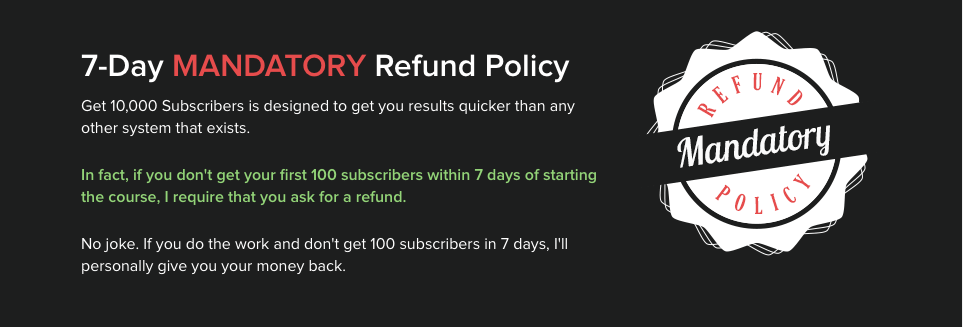
And we made sure all of our email and sales page copy clearly communicated this policy. (We even added a more detailed version with the exact work you’d need to complete to get a refund.) Then we put links to the policies on the sales page, all check-out pages and upsell pages.
We decided to use an action-based refund policy for two reasons:
Reason #1: It filters out tire kickers by scaring off people who aren’t 100% committed. (I’ve discovered that we aren’t a good place to go for people with this mindset.)
Reason #2: It pushes people to do the work instead of taking the easy way out and quitting.
Reason #3: It gives us a leg to stand on when complete yahoos buy the course and then ask for refunds despite never giving it an honest effort.
The results? The overall refund rate dropped to 3.16%!
= Success.
The goal for the next launch is to have a refund rate of less than 1%.
Tweak #2: Details on the coach I hired (and paid $10,000 to) and how that investment returned 10-fold
Just after the Spring launch of 10ksubs, I decided I needed to do two things in order to take the course to the next level.
Thing #1: Hire a coach.
Thing #2: Get partners to help sell the course.
So I went out and found the smartest affiliate manager (that’s what they call people who specialize in helping with partnerships) online.
His name is Stu McLaren.
If you don’t know Stu, you should. He’s one of the most kind and generous people I know. He worked with Michael Hyatt and helped launch their two flagship products, Best Year Ever and Platform University.
Together they’ve done well over $5 million dollars in sales with those two products of the last 2 years.
I figured if Stu was good enough for Michael, he’d be a home run for me.
So I sucked it up and hired Stu to coach me. It costs $10,000 for a day with him, but that investment paid off 20x.

I plan to share more about our time together over the coming months, but I can directly attribute just over $200,000 in sales to 2 strategies that Stu helped me implement during our time together.
Strategy #1: Partnerships to sell the course
Strategy #2: Using webinars during the launch
Moral of the story: Buy the most expensive coach you can afford to help you. Find someone who has been where you want to go. Get them to help you.
How we used affiliates (our affiliate recruitment and launch strategy)
The last major piece of this launch was getting other people who teach on topics that are related to list building to help me sell the course.
This is how it works:
Step 1: Find people who have people who would be interested in building their lists.
Step 2: Ask them if they’d like to sell 10ksubs and keep 50% of the sales they generate.
Step 3: They email their list about 10ksubs.
This is called affiliate sales.
This is something I’ll be writing more in depth about in Q1 of this year, but here are some key lessons I learned while doing our first affiliate launch:
Lesson #1: Hire someone to help you recruit, manage and communicate with your partners.
Lesson #2: Give your partners at least 90 days notice of your promotion.
Lesson #3: Make sure all of the tech pieces of the launch work and all sales bought through your partners’ links are attributed to them.
The results: Our partners accounted for just over $160,000 in sales and 20,000 new email subscribers.
More Q&A
There were a few other random things that people asked in the comments. I thought I’d respond to them all in one short little video.
Enjoy!
Note: This video was originally created in a live hangout on Blab.im. (Follow us over there to join future hangouts live.)
Conclusion (and huge shift for Videofruit in 2016)
So one big thing I learned in 2016 is that I need to have both a selfish and selfless goal.
The selfish goal should be something that’s mainly about me. This could be overall revenue, a particular email list size or even something more tangible like quitting my job (back when I had a day job) or making enough money for my wife to come home from her day job and help raise the kids.
Selfish goals are fun.
That’s mostly all I’ve ever focused on.
That’s all I’ve ever really seen examples of.
But there is another type of goal that’s really important: selfless goals.
These are goals that are pointed outward. In my case these would be goals that center around the success of my students.
My #1 goal for the second half of last year was 100% selfish.
It was to double my launch revenue from the first to second launch. $500k was the goal.
But I want to significantly change things this year…
What if in 2016 we completely changed the way we did things?
What if in 2016 my #1 goal wasn’t to double launch revenue (which would be $1 mil and completely insane) but what if instead my #1 goal was the success of every reader of this blog and student of 10ksubs?
What if your #1 goal was similar?
What if it wasn’t about you and how much you wanted to make? What if instead it was 100% centered around the success of your customers?
And what if we all held each other publicly accountable for that goal?
What if instead of selling courses or apps or coaching services and bragging about how much money we made…what if instead we bragged about how many people took our course and ACTUALLY GOT THE RESULTS HEY WERE AFTER!!??
And what if we made all of that public? For everyone to see. They could see how effective (or ineffective) our products actually are.
…
See, I think we’d all make fundamentally different decisions if that was our primary aim.
I know I would.
So…that’s what we’re doing at Videofruit in 2016.
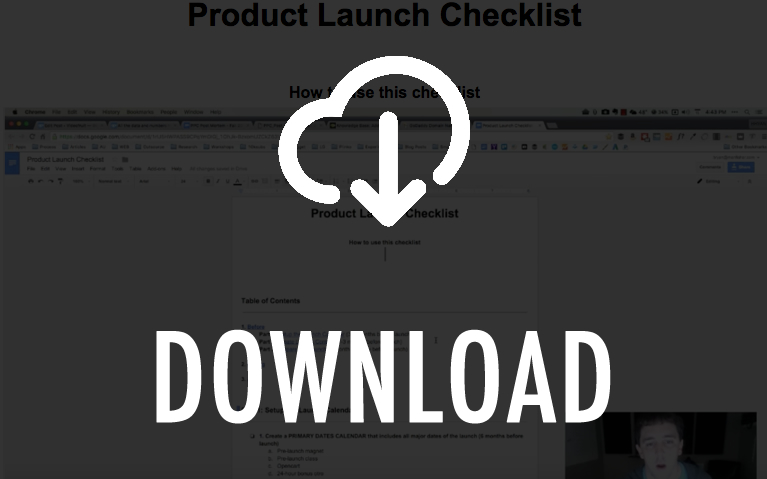
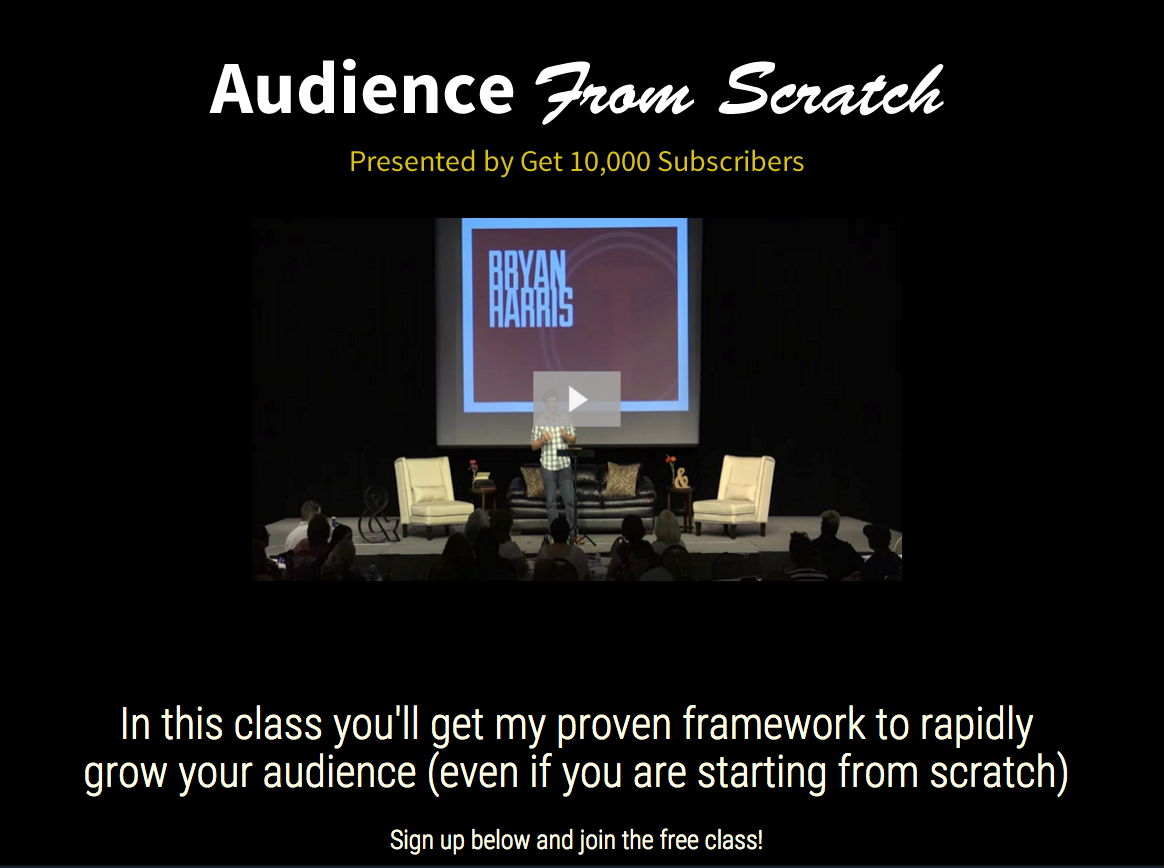
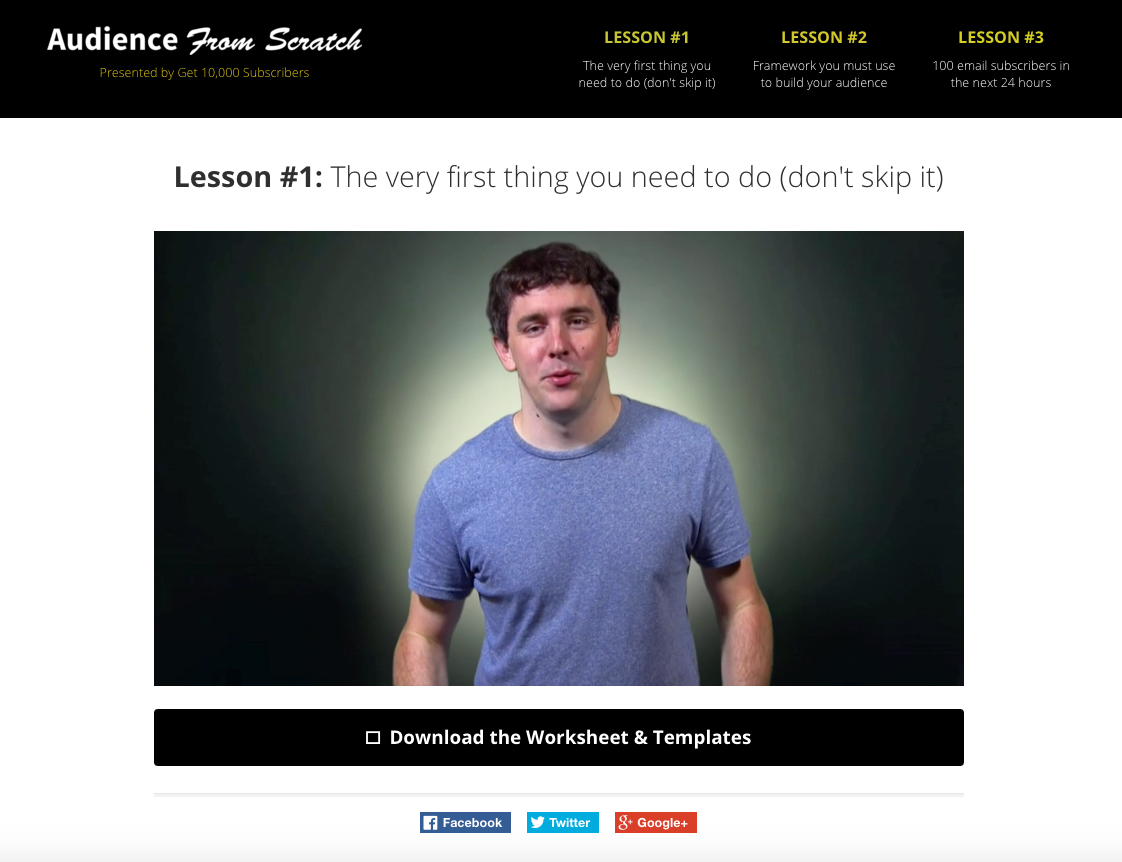
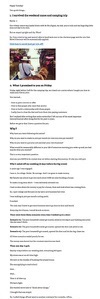
.jpg)